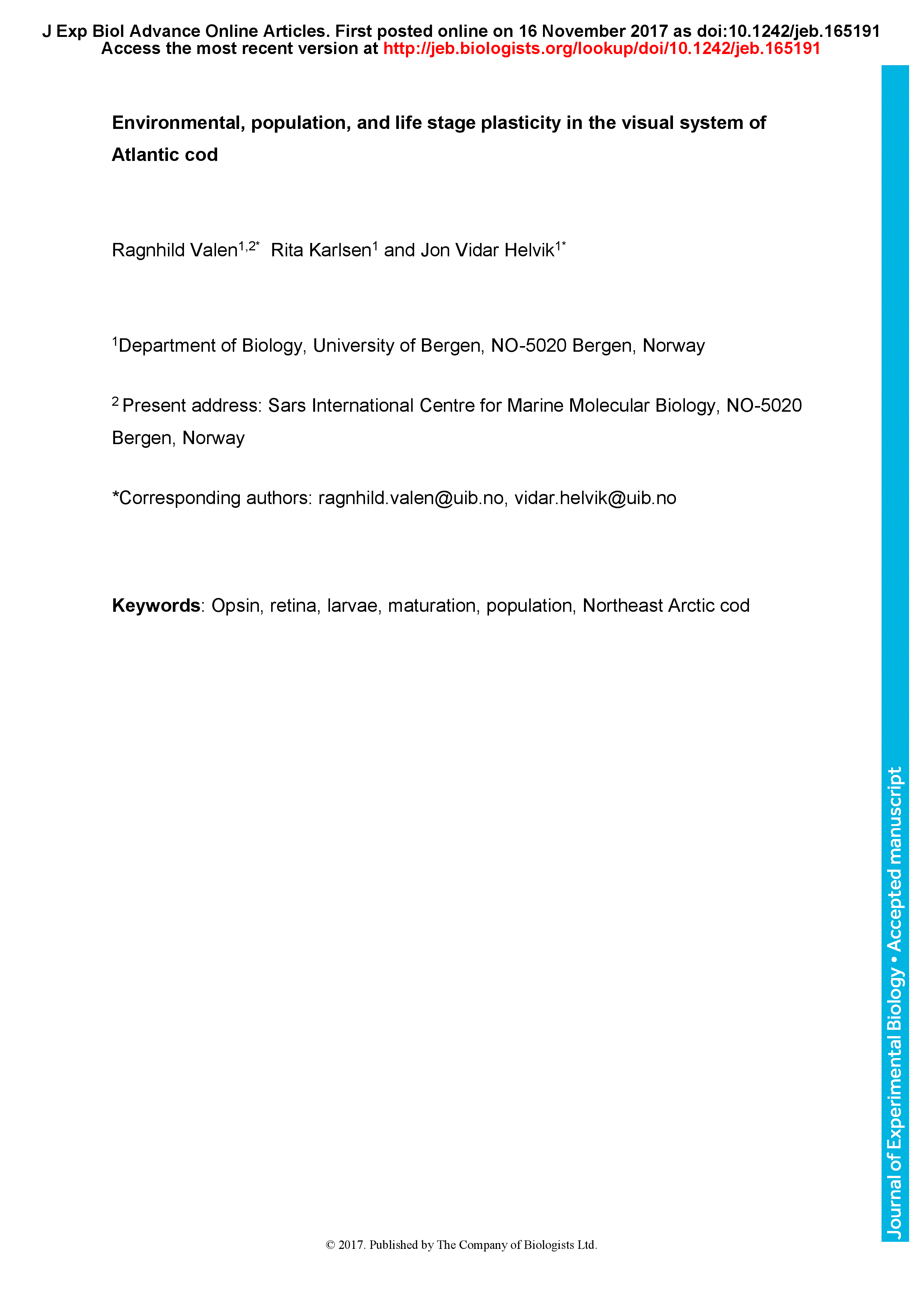The visual system is for many fishes essential in guiding behaviors such as foraging, predator avoidance and mate choice. The marine environment is characterized by large spatiotemporal fluctuations in light intensity and spectral composition. However, visual capabilities are restricted by both space limitations set by eye size, and by the genomic content of light absorbing opsin genes. The rich array of visual opsins in teleosts may be used differentially to tune vision towards specific needs during ontogeny, and to changing light. Yet, to what extent visual plasticity is a pre-programmed developmental event, or is triggered by photic environment, is unclear. Our previous studies on Atlantic cod revealed an evolutionary genomic loss of UV-sensitive sws1 and red-sensitive lws opsin families, while blue-sensitive sws2 and green-sensitive rh2 opsins had duplicated. The current study have taken an opsin expression approach to characterize visual plasticity in cod towards; different spectral light during the larval stage, to maturation, and extreme seasonal changes in the Barents Sea. Our data suggest that opsin plasticity in cod larvae is controlled by developmental program rather than immediate light environment. The lack of expressional changes during maturation, suggest a less important role for visual modulation related to mate choice. Although no seasonal effects on visual opsins were detected in migratory North East Arctic cod, the expressed opsin subset differed from the more stationary Norwegian Coastal cod described in previous studies. Interestingly these data provide the first indications of a population difference in actively used visual opsins associated with cod ecotypes.
Environmental, population, and life stage plasticity in the visual system of Atlantic cod
Currently Viewing Accepted Manuscript - Newer Version Available
Ragnhild Valen, Rita Karlsen, Jon Vidar Helvik; Environmental, population, and life stage plasticity in the visual system of Atlantic cod. J Exp Biol 2017; jeb.165191. doi: https://doi.org/10.1242/jeb.165191
Download citation file:
Advertisement
2023 JEB Outstanding Paper Prize shortlist and winner

The JEB Editors are delighted to announce the shortlisted authors for the 2023 JEB Outstanding Paper Prize. Read the winning paper - Tiny spies: mosquito antennae are sensitive sensors for eavesdropping on frog calls - by Hoover Pantoja-Sanchez and Brian Leavell from Ximena Bernal's lab at Purdue University, USA.
JEB Science Communication Workshop for ECRs

If you’re an early-career researcher interested in science communication and are attending the SEB Annual Conference in Prague this summer, come a day early and join the JEB Editors at a sci comm workshop to learn the key writing skills needed to promote your research to a broad audience beyond your peers (1 July at 14.30-17.30). Places are limited to 24 attendees, and applicants should apply through the SEB registration page by 30 April 2024.
Bridging the gap between controlled conditions and natural habitats in understanding behaviour

Novel technologies enable behavioural experiments with non-model species, in naturalistic habitats and with underexplored behaviours. In their Commentary, Scholz and colleagues discuss how to obtain a deeper understanding of the natural ecology and lifestyle of study animals.
Beluga metabolic measures could help save species

To help save animals from extinction, it’s important to understand what each species needs to survive. This led Jason John et al. to measure the metabolic rates of captive belugas to develop a ‘fish calculator’ showing that the whales need to eat ~23 salmon per day.
ECR Workshop on Positive Peer Review

Are you an ECR looking for tips on how to write concise, astute and useful manuscript reviews? If so, join the JEB Editors at a 2-hour JEB-sponsored Workshop on Positive Peer Review at the Canadian Society of Zoologists annual meeting in Moncton on 9 May 2024 at 13.00-15.00. There are 25 spaces for ECRs and selection is first come, first serve. To sign up, check the ECR Workshop box when you register for the CSZ meeting.



